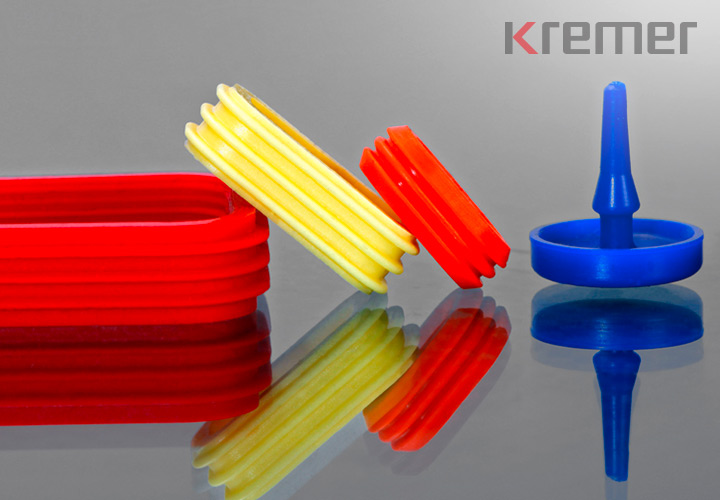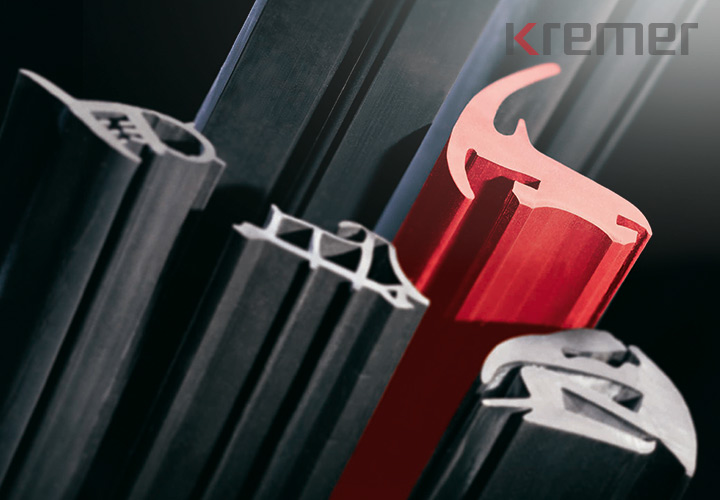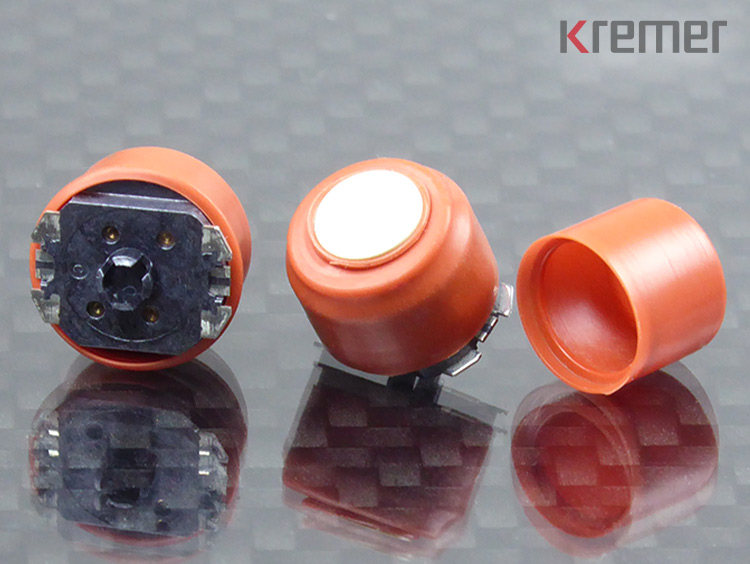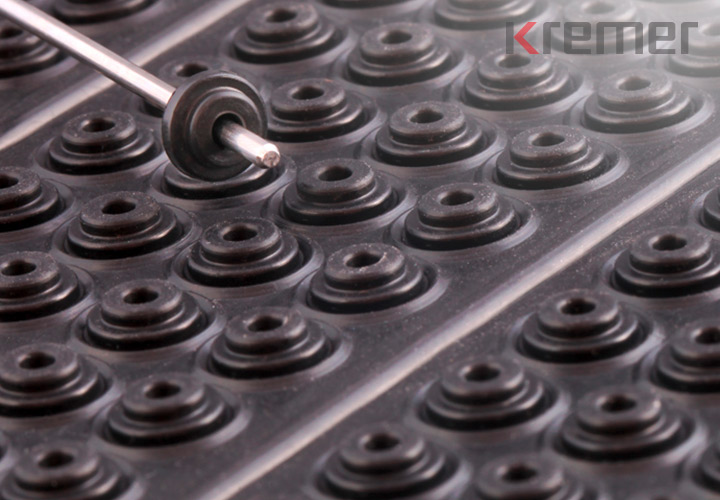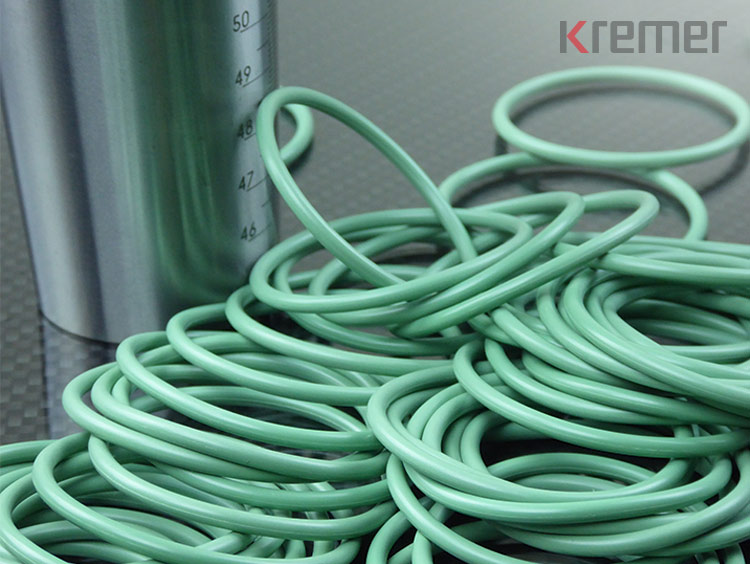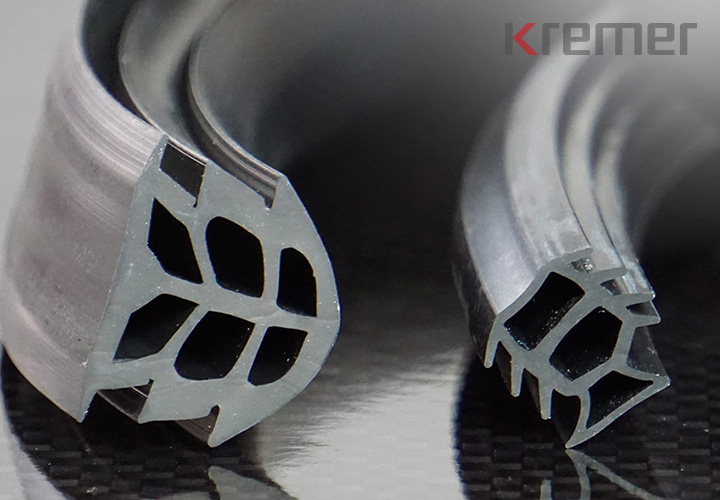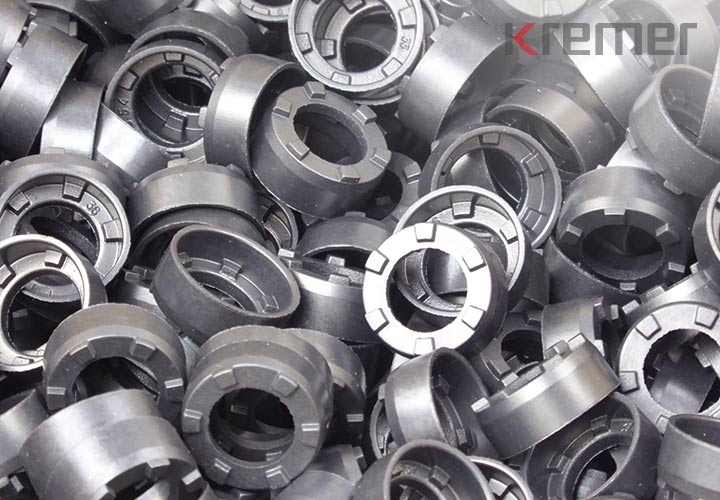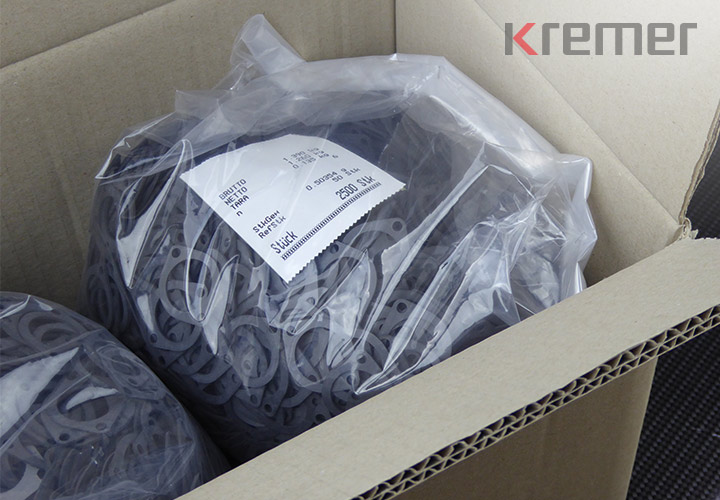Interesting facts about gaskets
Static and dynamic seals
Static seals impress as universal sealing elements with their simple installation, low space requirement and versatility in application. Unlike dynamic seals, static sealing applications have no play between the surfaces to be sealed or between the sealing surface and the mating surface. The seals are located between two static or stationary parts as a connecting and sealing element.
Dynamic seals are called dynamic because these seals are subject to movement. They are located between a static part and a rotating part.
Convince yourself of the KREMER reliability and quality that we deliver with every single seal and benefit from our expertise in the field of sealing technology.
Materials
A wide range of materials can be used in the manufacture of seals, which can fully utilise their properties depending on the sealing application. Of course, this requires that the appropriate elastomer is also selected. The various materials used to make gaskets are not always equally resistant to the medium to be sealed or to the prevailing temperature. For example, seals made of EPDM are resistant to brake fluid, but not to petrol.
The exact opposite is true for NBR. In this case, seals in the fuel sector or in brake systems must be selected separately. In addition to media resistance and the operating temperature range, the mechanical-technological values of an elastomer compound are also criteria for material selection. Seals can be made from the following materials, among others:
The term EPDM stands for ethylene propylene diene rubber. This material is one of the most widely used in industry. Seals made of EPDM are characterised by excellent resistance to water, alcohol, acids, alkalis, hot water and steam.
The material is also resistant to ozone and weathering as well as oxygen and UV radiation. EPDM gaskets are superior to other materials in terms of ageing. However, EPDM gaskets are not recommended for contact with oils, greases, mineral oil products or hydrocarbons, as the material swells considerably and the mechanical properties are impaired.
The material is widely used in glycol-based brake systems, and EPDM also has very good electrical insulation properties. The temperature range in which EPDM seals can be used is -40°C to +140°C. EPDM is also known under the trade names BUNA-AP®, DUTRAL®, KELTAN®, NORDEL® and VISTALON®.
Silikondichtungen are primarily used when high resistance to heat, cold, weathering, oxygen, ozone and UV rays is required.
They are also resistant to ageing and weathering and have excellent electrical insulating properties. The thermal application range of the material extends from -55°C to +200°C, while also retaining their elasticity. Their physiological harmlessness also makes them suitable for use in medical and food-related areas. However, silicone is not resistant to acids, alkalis, silicone greases and oils, aromatic mineral oils or fuels.
Silicone seals are just as unsuitable for sealing applications where gas-tightness is important as they are for dynamic use, as their tear resistance is relatively low and they have a high coefficient of friction.
The abbreviation NBR is derived from acrylonitrile butadiene rubber. In chemical terms, this is a copolymer of butadiene and acrylonitrile. The latter accounts for around 18 to 50% of commercial compounds. The higher the proportion of nitrile, the greater the resistance to hydrocarbon fuels and mineral oil products. However, this has a negative effect on the flexibility of the material when used at low temperatures. However, there are low-temperature compounds that are specially designed for sealing applications that are carried out in contact with mineral oil-based liquids.
The operating temperature range of NBR gaskets is -35°C to +120°C. NBR is superior to other sealing materials not only in terms of abrasion and tear resistance, but also in terms of compression set.
However, resistance to weathering, UV radiation and ozone is low - this must be taken into account, especially during storage. Special additives can compensate for some of these weak points.
NBR is resistant to air, water (up to approx. +80°C), oils, greases, lubricants, silicone oils and greases as well as flame retardants. The material is therefore widely used for applications in pneumatics and hydraulics. However, NBR is not suitable for sealing applications in fuels with a high aromatic content, in glycol-based brake fluids, in polar solvents or in chlorinated and aromatic hydrocarbons.
Seals made of H-NBR are designed for a temperature range of -30°C to +150°C and have a high mechanical strength; their media resistance is comparable to that of NBR seals.
The perfluoroelastomer FFKM, on the other hand, is suitable for seals that are exposed to high heat or aggressive media. The material FKM, also known under the trade name Viton®, is used for sealing applications where high mechanical values and enormous resistance to aromatic and aliphatic hydrocarbons and chlorinated hydrocarbons, weak alkalis, diluted acids and mineral oils are required. The temperature range of this highly ageing-resistant material extends from -20°C to +220°C, and FKM also has very good compression set.
PTFE seals with a Shore hardness of approx. 95°, on the other hand, are not elastic, but they can be used in a very wide temperature range, from -200°C to +230°C. With the exception of some fluorine compounds and liquid alkali metals, PTFE is very resistant to chemicals and has good sliding properties.
Types of gasket manufacture
Seals are omnipresent in industry and everyday life. How are they manufactured and which manufacturing processes can be used? Depending on the requirements for the gasket - such as the material used, the required quantity or geometry - a manufacturer has a range of options to choose from. In this article, KREMER explains several proven processes in gasket production and presents their properties in more detail.
Punched gaskets or self-adhesive on film - the specialist consultants know the specifications of the products on offer.
In addition, water jet cutting of flat gaskets offers a great deal of flexibility and quick response options when short-term geometry changes to the gasket are required.
Three tolerance classes - P1 (fine), P2 (medium) and P3 (coarse) - are defined in DIN 7715 Part 5 for punched flat gaskets and flange gaskets. For water jet-cut gaskets, on the other hand, DIN 2768 Part 1 applies. You can use the tolerance calculation tool from KREMER to determine which tolerance class is right for you.
Punching or water jet cutting have proven themselves for flat gaskets. Punched flat gaskets can be produced in large quantities in a relatively uncomplicated and quick manner and with low tool costs. Depending on how thick and soft the gasket material is, the cut pattern can be concave. If this is to be avoided, extremely precise water jet cutting can be used to achieve right-angled cut surfaces. In this way, very thin wall thicknesses can be achieved with a consistently clean and precise edge cut.
Extrusion is used to manufacture profile seals made of EPDM and silicone. In this extrusion process, the material to be processed is continuously pressed through the extrusion tool, a moulding die, under high pressure. This creates an endless profile that can be further processed in different ways depending on the application, for example made up into sections, glued into rings or corner vulcanised into frames.
It is also known as injection moulding, whereby the rubber is plasticised and homogenised by frictional heat via a screw in the injection unit. It is then fed into the heated mould via sprue channels. The pressure, temperature and speed at which the material is injected into the mould can be precisely controlled.
Injection moulding is therefore much more precise than compression moulding. The end product also requires no post-processing. In contrast, specially designed injection moulding machines are used for seals made from liquid silicone, as the two-component material has an extremely low viscosity and therefore requires maximum mould precision during injection.
The injection moulding process is ideal for large series of small seals made of silicone, NBR or EPDM, for example, where high tolerances are required. It is a fast, simple and cost-effective process with a high level of repeatability, and compared to compression moulding, injection moulding is the much more modern manufacturing option for technically high-quality seals.
If you are looking for a manufacturing process that combines the advantages of injection moulding and compression moulding, injection transfer moulding is an excellent combination. As with injection moulding, the process can be easily automated and controlled, while the plasticised rubber mixture is not injected directly into the mould, but into the transfer unit in the upper part of the mould via an injection unit. The fact that the rubber mixture is already plasticised means that the vulcanisation mould can be filled more evenly. The transfer chamber is closed by the closing pressure of the machine and the compound is pressed into the moulds.
Storage and shelf life
The storage life of gaskets depends crucially on the environment. What is certain is that the properties of gaskets remain virtually unchanged for several years, provided they are stored or handled properly.
Optimum storage conditions
A cool, dry, moderately ventilated and dust-free storage room is essential. Gaskets should be stored in a temperature range between +5 and +20 °C.
The seals should be protected from daylight and sources of ozone in closed containers. It is best to leave the gaskets in the cardboard boxes and film bags supplied by us. Under these conditions, a change in the rubber-elastic properties is significantly reduced and a longer storage period and shelf life is possible.
Excessive weight, tension, pressure or external damage caused by other objects must be avoided at all costs in order to prevent deformation.
If these instructions are observed, the usability of the seals will not be significantly impaired for many years.
CR: | 4 years |
NBR: | 4 years |
EPDM: | 6 years |
MVQ: | 10 years |
FFPM/FFKM: | 10 years |
Consequences of inadequate storage
Rubber seals can change their physical properties under unfavourable storage conditions. Various influencing factors can lead to cracks, permanent deformation or severe hardening, which severely impairs the functionality of the seals and means that they can no longer be used.
Compliance with storage recommendations in accordance with DIN 7716 also applies in particular to gaskets that are fitted with a self-adhesive film to ensure overhead installation or loss-proof transport of a pre-assembled gasket. Please refer to our product information on the correct storage of self-adhesive gaskets.
Further information on the storage, maintenance and cleaning of rubber products can be found in DIN 7716.
Quantity determination of stamped parts
In the case of stamped gaskets, the distribution of the thickness dimensions and therefore the unit weights is directly dependent on the semi-finished product used, the so-called sheet or roll material. The tolerance according to DIN 3302-1 class P3 for the thickness of 3 mm applied by the manufacturers of sheet and roll goods is already ±0.4 mm. This tolerance is also fully utilised by the manufacturers of the semi-finished product for production reasons. This means that a stamped gasket can have a maximum thickness of 3.4 mm and a minimum thickness of 2.6 mm.
Depending on the material consumption, sheet and roll material with different thickness tolerances can be used for the production of die-cut gaskets, making it difficult for you to determine the number of pieces downstream in the incoming goods department.
In the case of stamped parts, we sometimes do not specify a quantity determined on the basis of reference parts, but instead refer to the product of the multiplication of the number of stamping strokes and the number of panels per stroke when specifying the quantity on the delivery note.
KREMER-Tipp
In order to be able to determine an approximately equal number of pieces compared to our delivery note specification during the incoming goods inspection of delivered rubber stamped parts, the largest possible number of seals from several packaging units should be used as a reference weighing part.
Loss of tightness due to electrolytic corrosion
Static seals have the task of reliably sealing two separate installation spaces. In individual cases, rubber materials tailored to the intended use are used for this purpose, which can withstand environmental influences such as heat, weather or media contact.
In order to achieve the sealing effect, the geometry to be pressed and the hardness of the seal play an important role in the design of the sealing system. However, even if the user takes into account the information on the surface properties of the sealing surfaces, the formation of rust on susceptible metallic sealing surfaces can lead to corrosive infiltration of the sealing system if an ion-conducting medium (electrolyte) passes through the housing gap, attacks metallic surfaces susceptible to corrosion and ultimately dissolves as a result of electrochemical reactions.
If the electrolyte can penetrate to the seal, the metallic surface in the edge area of the seal is also damaged. The formation of rust is accompanied by an increase in the volume of the corroded metal, so that the seal is exposed to a constant increase in pressure from the edge area as corrosion progresses - the seal is successively lifted. Capillary action develops under the seal and the electrolyte can penetrate further under the seal until it is completely infiltrated. Over time, it loses its function: the sealing system must be labelled as leaking.
What needs to be considered?
To prevent infiltration of the sealing system, it must be ensured that the housing parts touch each other at the gap entrance. A first groove geometry or a free space must be provided directly behind the housing interior in order to minimise the capillary effect of the gap. The housing parts should then touch a second time and the seal should only be seated in the second groove. In the pressed state of the seal, the widest possible sealing geometry and the highest possible hardness of the sealing material counteract the infiltration of the seal, but also cause higher closing forces, so that the housing parts must also be designed to be stiffer.
PAHs - hopefully not literally on everyone's lips
Polycyclic aromatic hydrocarbons, also known as PAHs, are a group of chemical benzene compounds. They are tiny solid particles that are present in many variations of crude oil in nature, with a proportion of approx. 0.2% to approx. 7%. As a result of petroleum refining, they are also found in important formulation components of rubber compounds such as plasticisers and industrial carbon blacks and subsequently also in seals. Specific PAH types are classified by the European Union as carcinogenic, mutagenic or toxic to reproduction. Once released into the environment, they accumulate indefinitely in soil, plants and the air and degrade only poorly. Care must therefore be taken to minimise the use of chemicals containing PAHs.
PAH-free gaskets are gaskets with an analytically determined PAH concentration of <0.2 mg/kg. Concentrations of <10 mg/kg are considered low-PAH gaskets.
For rubber gaskets that come into direct, prolonged or repeated contact with the skin or oral cavity for a short period of time during normal or reasonably foreseeable use, an EU regulation has been in force since 2015 that sets a limit value of 1 mg/kg for eight defined PAHs.
For rubber seals with food contact, for example, this means that the formulation, which sometimes consists of 10-15 components, has to be revised and substances containing PAHs have to be replaced by alternatives.
As it is often not possible to do without carbon blacks in elastomer compounds due to their properties, low-PAH carbon blacks from special manufacturing methods must be used.
Compliance with legal regulations on environmental and health protection
At KREMER, we take environmental protection and the safety of both our own employees and our customers very seriously. Compliance with the legal regulations that are imposed on us during production is a matter of course for us.

